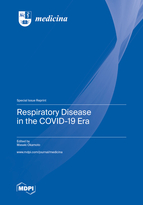Respiratory Disease in the COVID-19 Era
A special issue of Medicina (ISSN 1648-9144). This special issue belongs to the section "Pulmonary".
Deadline for manuscript submissions: closed (31 March 2023) | Viewed by 21675
Special Issue Editor
Interests: respirology; diffuse lung disease
Special Issues, Collections and Topics in MDPI journals
Special Issue Information
Dear Colleagues,
Coronavirus disease 2019 (COVID-19) is a new respiratory disease caused by infection with severe acute respiratory syndrome coronavirus 2 (SARS-CoV-2) that caused a global pandemic. COVID-19 patients often develop acute respiratory distress syndrome (ARDS), which involves acute and lethal respiratory failure. In a meta-analysis, the median incidence of ARDS in COVID-19 patients was found to be 35 (2-79)%, while the mortality rate in COVID-19-associated ARDS patients was found to be 39 (12.5-73.1)% (Hasan, et al. Expert Rev Repoir Med. 2020; 14: 1149). As of 12 December 2021, 270,373,764 cases had been confirmed as COVID-19 and 5,321,321 cases had resulted in death, according to the World Health Organization webpage.
Various symptoms such as persistent fatigue, myalgia, and insomnia can persist after recovery from COVID-19; these symptoms are called “long COVID-19”. Patients with COVID-19 who survive but develop pulmonary fibrosis may experience persistent dyspnea upon exertion, a decrease in pulmonary function, and/or a radiological abnormal shadow. Antifibrotic drugs including nintedanib and pirfenidone are candidate drugs for the treatment of pulmonary fibrosis due to COVID-19; randomized controlled trials are ongoing.
However, there are limited studies about respiratory disease caused by COVID-19. Given the clinical significance of this topic and its impact on clinical practice and public health, Medicina is launching a Special Issue entitled “Respiratory Disease in the COVID-19 Era” with the aim of gathering accurate and up-to-date scientific information of this topic. We are pleased to invite you and your co-workers to submit your original articles. We also encourage the submission of original manuscripts spanning basic to clinical research and focusing on respiratory disease due to COVID-19. We would also like to invite you to submit review articles aimed at providing a comprehensive overview of the recent advances in understanding its pharmacological aspects. Interesting case reports of respiratory disease due to COVID-19 are also welcome.
Dr. Masaki Okamoto
Guest Editor
Manuscript Submission Information
Manuscripts should be submitted online at www.mdpi.com by registering and logging in to this website. Once you are registered, click here to go to the submission form. Manuscripts can be submitted until the deadline. All submissions that pass pre-check are peer-reviewed. Accepted papers will be published continuously in the journal (as soon as accepted) and will be listed together on the special issue website. Research articles, review articles as well as short communications are invited. For planned papers, a title and short abstract (about 100 words) can be sent to the Editorial Office for announcement on this website.
Submitted manuscripts should not have been published previously, nor be under consideration for publication elsewhere (except conference proceedings papers). All manuscripts are thoroughly refereed through a single-blind peer-review process. A guide for authors and other relevant information for submission of manuscripts is available on the Instructions for Authors page. Medicina is an international peer-reviewed open access monthly journal published by MDPI.
Please visit the Instructions for Authors page before submitting a manuscript. The Article Processing Charge (APC) for publication in this open access journal is 1800 CHF (Swiss Francs). Submitted papers should be well formatted and use good English. Authors may use MDPI's English editing service prior to publication or during author revisions.
Keywords
- COVID-19 (coronavirus disease 2019)
- SARS-CoV-2 (severe acute respiratory syndrome coronavirus 2)
- acute respiratory distress syndrome
- dyspnea







